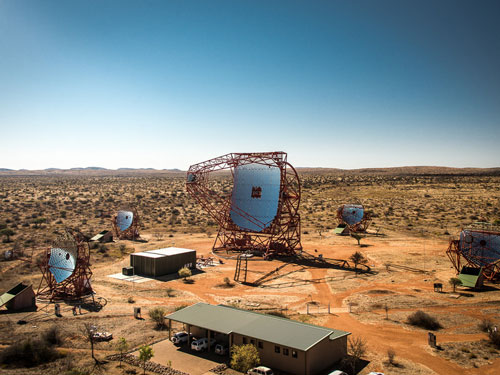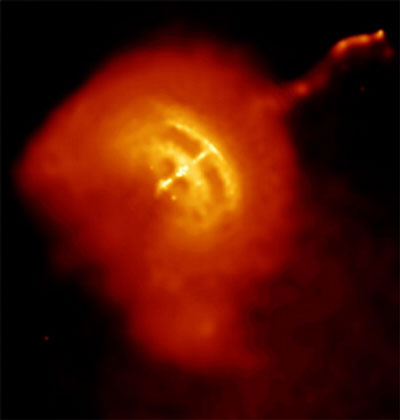| Jul 03, 2014 |
Sights are set on the Vela pulsar
|
|
(Nanowerk News) The Vela pulsar provided a successful premiere for the new 28-metre Cherenkov telescope in Namibia. The pulsed radiation from Vela is the first to be measured in the southern sky and the performance of the High Energy Spectroscopic System (H.E.S.S.) has been proved once again. The celestial body in the Vela (sail) constellation is thus only the second pulsar ever from which gamma rays have been detected by a ground-based telescope. The construction and set-up of the 28-metre telescope was led by the Max Planck Institute for Nuclear Physics in Heidelberg.
|
 |
| Successful novice: The 28-metre H.E.S.S. II telescope integrated into the H.E.S.S. Cherenkov telescope array. (© MPIK/Christian Föhr)
|
|
This discovery has been accessible by the operation of the new 28-meter diameter telescope. Construction of the telescope structure has been led by the Max-Planck-Institute for Nuclear Physics (MPIK). Michael Panter, the coordinator of the telescope construction said: “Building the largest telescope of its kind was very challenging. We had to mount 600 tons of steel with high precision. This telescope will enable us to study new source types and explore a wide range of astrophysical phenomena.” About 50% of the project’s funding was granted by the Max Planck Society. The instrumentation of the focal plane was developed in France.
|
|
Since the upgrade of the H.E.S.S. experiment in Namibia in 2012, H.E.S.S. II with its fifth and larger Cherenkov telescope CT5 is the first Cherenkov telescope system with telescopes of different sizes detecting cosmic TeV gamma rays in sync. CT5 is placed in the centre of the system, extends the energy range to lower energies and allows for the detection of cosmic particle accelerators down to 30 GeV. In cooperation with scientists throughout Europe, a tailor-made reconstruction analysis was developed for these low-energy gamma rays. With this, H.E.S.S. scientists were able to detect a pulsed, repeating gamma-ray signal in the energy range of 30 GeV and attribute it to the Vela pulsar. This opens the door to new observation possibilities of the inner Galaxy. The first results presented at a conference on June 23 2014 by Christian Stegmann, spokesperson of the H.E.S.S. collaboration.
|
 |
| Stormy universe: The Vela pulsar and the pulsar wind nebula surrounding it, as seen by the Chandra X-ray satellite. (© NASA/CXC/PSU/G.Pavlov et al.)
|
|
Besides intensive efforts in the construction and calibration of CT5, two years of intensive software development determined this success. “For the reconstruction of the data from CT5, we elaborated a highly sensitive analysis based on extremely complex statistical algorithms. This allows us to detect gamma radiation of only 30 GeV from ground level,” explains Wilfried Domainko, from the local H.E.S.S. experimental group at MPIK. “Since we are able to survey a projected area of 10 hectares in the atmosphere, we have a considerably higher yield of gamma rays than for example satellite experiments like Fermi LAT.” From some sources, it is possible to spot up to one gamma per second – a record.
|
|
The data reveal regular gamma ray pulses, repeating every 89 milliseconds, coming exactly from the direction of the Vela pulsar. The reconstructed energies of these gamma rays are in the range of 30 GeV. This shows that H.E.S.S. for the first time successfully measured pulsed radiation in the southern sky.
|
|
“The whole Milky Way is full of pulsars and from Namibia we can exactly see into its centre. The H.E.S.S. data show that, with Cherenkov telescopes, we will still discover quite a number of mysteries in the universe,” beams Werner Hofmann, director at the MPIK in Heidelberg.
|
|
Cherenkov telescope systems consist of large segmented mirrors which focus optical Cherenkov light flashes. These flashes are generated in the atmosphere, last only a few nanoseconds and are invisible for the human eye. They are generated by cascades of elementary particles triggered by cosmic radiation. With highly sensitive cameras, Cherenkov telescopes take pictures of events which allow to identify gamma radiation to construct images of cosmic particle accelerators which emit this kind of gamma radiation. The H.E.S.S. telescopes are operated by an international collaboration including a strong involvement of German universities and more than 30 institutions in 11 countries: Germany, France, United Kingdom, Namibia, South Africa, Ireland, Armenia, Poland, Australia, Austria and Sweden. H.E.S.S. is the only such system in the southern hemisphere and the only one with different reflector sizes. Therefore, H.E.S.S. ideally paves the way for the Cherenkov Telescope Array CTA, planned in international collaboration, which as from 2017 will be built with a total of about 100 Cherenkov telescopes of three sizes, distributed over two sites.
|


